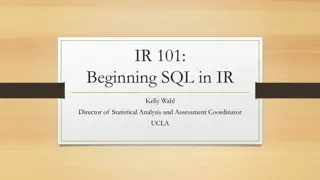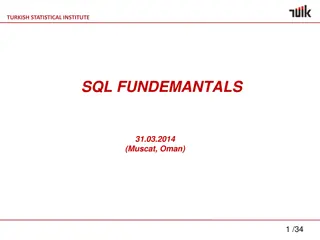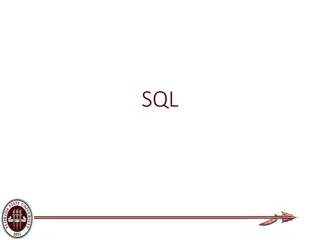Advanced SQL Query Techniques
Diving into advanced SQL query techniques such as removing duplicate values, sorting results in ascending or descending order, limiting and filtering records using WHERE clause with various operators. Explore practical examples for a better understanding of SQL queries.
Download Presentation

Please find below an Image/Link to download the presentation.
The content on the website is provided AS IS for your information and personal use only. It may not be sold, licensed, or shared on other websites without obtaining consent from the author.If you encounter any issues during the download, it is possible that the publisher has removed the file from their server.
You are allowed to download the files provided on this website for personal or commercial use, subject to the condition that they are used lawfully. All files are the property of their respective owners.
The content on the website is provided AS IS for your information and personal use only. It may not be sold, licensed, or shared on other websites without obtaining consent from the author.
E N D
Presentation Transcript
INLS 623 ADVANCED SQL Instructor: Jason Carter
SQL SELECT DISTINCT SELECT DISTINCT column_name,column_name FROM table_name;
A column may contain many duplicate values; and sometimes you only want to list the distinct values Duplicate rows
REMOVING DUPLICATE SALARIES select distinct salary from employees
SORTING RESULTS SELECT column_name,column_name FROM table_name ORDER BY column_name,column_name ASC; SELECT column_name,column_name FROM table_name ORDER BY column_name,column_name DESC; ASC means ascending order 1,2,3,4,5,6 DESC means descending order 6,5,4,3,2,1 ASC is default
SORTING RESULTSIN ASCENDING ORDER select distinct salary from employees order by salary
SORTING RESULTSIN DESCENDING ORDER select distinct salary from employees order by salary desc
RETURNA CERTAINNUMBEROF RESULTS SELECT column_name,column_name FROM table_name ORDER BY column_name,column_name LIMIT value; Value is an actual number SELECT column_name,column_name FROM table_name ORDER BY column_name,column_name LIMIT 10;
LIMIT EXAMPLE select distinct salary from employees limit 5
FILTERING RECORDS Use the where clause SELECT column_name,column_name FROM table_name WHERE column_name operator value; operator
WHERE CLAUSE EXAMPLE select distinct salary from employees where salary = 18050.00
WHERE OPERATORS > < >= <= <> or != These operators are straightforward
LIKE OPERATOR The LIKE operator is used in a WHERE clause to search for a specified pattern in a column SELECT column_name(s) FROM table_name WHERE column_name LIKE pattern; How do we specify a pattern?
LIKEAND WILDCARDS EXAMPLE % wildcard select ename from employees where ename LIKE 'J%'
LIKEAND WILDCARDS EXAMPLE select ename from employees where ename LIKE 'John William_'
IN OPERATOR The IN operator allows you to specify multiple values in a WHERE clause It is like an or SELECT column_name(s) FROM table_name WHERE column_name IN (value1,value2,...);
IN OPERATOR EXAMPLE SELECT * FROM flights WHERE origin IN ('Los Angeles','Madison');
BETWEEN OPERATOR The BETWEEN operator is used to select values within a range. SELECT column_name(s) FROM table_name WHERE column_name BETWEEN value1 AND val ue2; The values can be numbers, text, or dates.
BETWEEN EXAMPLE SELECT * FROM flights WHERE distance between 100 and 500 order by distance
NOT BETWEEN The BETWEEN operator is used to select values outside of a range. SELECT column_name(s) FROM table_name WHERE column_name NOT BETWEEN value1 AND value2;
NOT BETWEEN EXAMPLE SELECT * FROM flights WHERE distance not between 100 and 500 order by distance
TEMPORARILY RENAME TABLEOR COLUMN SQL aliases are used to give a database table, or a column in a table, a temporary name. Columns SELECT column_name AS alias_name FROM table_name; Tables SELECT column_name(s) FROM table_name AS alias_name;
ALIAS EXAMPLE Select ename as "Employee Name" from employees
JOINS Used to combine rows from two or more tables, based on a common field between them. The most common type of join is the inner join You can type inner join or join
INNER JOIN Returns all rows when there is at least one match in BOTH tables Two tables Faculty and class Want to know the class name and who is teaching the course (faculty name) How would you write this without using joins? select faculty.fname, class.class_name from faculty, class where faculty.fid = class.fid
INNER JOIN Faculty Class A set of records which match in both the faculty and class table, i.e. all faculty who teach a course.
INNER JOIN EXAMPLE select faculty.fname, class.class_name from faculty inner join class on faculty.fid = class.fid;
LEFT JOIN The LEFT JOIN keyword returns all rows from the left table (table1), with the matching rows in the right table (table2). The result is NULL in the right side when there is no match. Faculty Class A set of records which match all of the rows in the faculty table with matching rows in the class table, i.e. all faculty and their courses regardless of whether they teach a course
LEFT JOIN EXAMPLE select faculty.fname, class.class_name from faculty left join class on faculty.fid = class.fid; Faculty who don t teach a course
RIGHT JOIN The RIGHT JOIN keyword returns all rows from the right table (table2), with the matching rows in the left table (table1). The result is NULL in the left side when there is no match. Class Faculty A set of records which match all of the rows in the class table with matching rows in the faculty table, i.e. all classes and faculty regardless of whether there is a faculty member teaching the course
RIGHT JOIN EXAMPLE select faculty.fname, class.class_name, faculty.fid from faculty right join class on faculty.fid = class.fid; Class with no faculty
SQL AGGREGATE FUNCTIONS SQL aggregate functions return a single value, calculated from values in a column avg() count() max() min() sum()
AVG OR AVERAGE The AVG() function returns the average value of a numeric column SELECT AVG(column_name) FROM table_name
AVG EXAMPLE Get the average cruising range of aircraft select avg(cruisingrange) as "Average Cruising Range" from aircraft
COUNT The COUNT() function returns the number of rows that matches a specified criteria Column name SELECT COUNT(column_name) FROM table_name; Count the number of records in the table SELECT COUNT(*) FROM table_name; Count number of distinct columns SELECT COUNT(DISTINCT column_name) FROM table_name;
MAX The MAX() function returns the largest value of the selected column. SELECT MAX(column_name) FROM table_name;
MAX EXAMPLE select max(salary) as "highest salary" from employees;
MIN The MIN() function returns the smallest value of the selected column SELECT MIN(column_name) FROM table_name;
MIN EXAMPLE select min(salary) as "lowest salary" from employees;
GROUP BY Used in conjunction with the aggregate functions to group the result-set by one or more columns. Used to group rows into subgroups by the one or more values of columns. SELECT column_name, aggregate_function(column_name) FROM table_name WHERE column_name operator value GROUP BY column_name;
GROUP BY EXAMPLE How many items each supplier sells? select sid, count(sid) from catalog group by sid What if we want to know the supplier s name?
GROUP BY EXAMPLE How many items each supplier (the name of the supplier) sells? We need the suppliers and catalog table select suppliers.sname, count(catalog.sid) as "number of items" from catalog join suppliers on catalog.sid = suppliers.sid group by catalog.sid
HAVING Used to to specify a filter condition for groups of rows or aggregates. Often used with GROUP BY SELECT column_name, aggregate_function(column_name) FROM table_name WHERE column_name operator value GROUP BY column_name HAVING aggregate_function(column_name) operator value;
HAVING EXAMPLE The suppliers (name) that sell 3 or more items. select suppliers.sname, count(catalog.sid) as "number of items" from catalog join suppliers on catalog.sid = suppliers.sid group by catalog.sid having count(catalog.sid) >= 3
SUBQUERY A query that is nested inside another query SELECT * FROM table_name WHERE column_name = (SELECT column_name FROM table_name)
SUBQUERY EXAMPLE select max(salary) as "highest salary" from employees; We also want to know the employee s name with the highest salary. select ename, max(salary) as "highest salary" from employees where salary = (select max(salary) from employees);
VIEWS A database view is a virtual table or logical table
VIEWS You can query against a view When the data of the tables changes, the view reflects that changes as well A database view allows you to simplify complex queries A database view helps limit data access to specific users A database view provides extra security layer. (read only)























